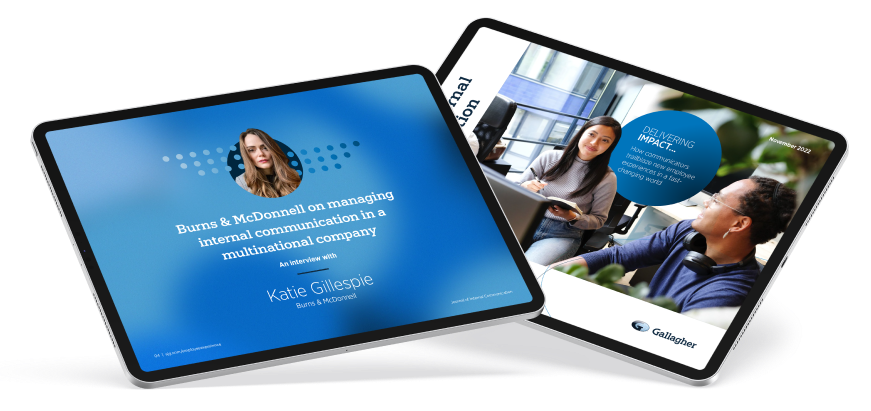In just eight months, multicloud technology services company Rackspace Technology went from post-pandemic employee engagement lows to historic highs. EMEA COO, Liz Parnell, and Head of EMEA Internal Communications, Claire Widd, explain how a data-led approach and a focus on a clear narrative made all the difference.
Gallagher: Your campaign, which won a Gold Award at the Internal Communications and Engagement Awards, is a great example of a company reinventing its employee communications & engagement strategy post-pandemic. Can you tell us a bit more about how it all started and the challenges you were facing?
LP: We'd just appointed a new leadership team in EMEA and were digesting the results of our employee engagement survey. Data showed that engagement was low. Our people — who we call Rackers — were not getting the messages they needed to hear, and internal communication was disjointed across the region.
Like many organizations faced with the challenges of remote working, our community spirit and sense of purpose had dropped a little. And that was a big loss, because previously there had been a really dynamic vibe around the office.
Gallagher: How did you go about addressing those challenges? It must have been a daunting prospect given the context. Presumably it meant developing a completely new internal communication strategy?
CW: We regularly measure Racker confidence in our strategy through employee net promoter score (ENPS). At the beginning of May 2021, our ENPS in EMEA was at minus 35 — the lowest it had been since early 2019.
Based on feedback from Rackers, we took a campaign-based approach, and devised a plan that put them back at the heart of what we do in the region.
There were three pillars to it; the first was around defining a clear, repeatable narrative which linked our focus in EMEA to the wider global strategy. We needed to reconnect with Rackers in a simple way, consistently repeating core messages on familiar channels so people understood our plan and how we would get there together. We pulled in our senior leaders to reinforce that.
The second pillar was improving Rackers' connection and engagement with the new leadership team; helping them to connect on a personal and professional level. The third was about evolving our channel framework to support better engagement with our strategy and enable better support for people managers for team-level communications.
LP: We stripped out the corporate jargon, so people feel like we're talking to them as fellow humans. And we try and make it as interactive as possible.

Refreshed employee-centric communication channel framework
Gallagher: Could you expand on what you did for the second pillar? What were your tactics for boosting that sense of connection between the leadership team and Rackers and making them more visible?
CW: Initially, we repositioned our flagship town hall events (Open Book) where we share our quarterly performance, strategy updates and key topics by simplifying and standardising our agenda to make it repeatable and familiar. Later, we introduced an add-on, Open Book+ to give Rackers additional opportunities to directly engage with our strategy.
These are also a great opportunity for Rackers to interact with the leadership team. While we host them at the office, they are accessible to everyone, and people can join virtually from wherever they are in the region to hear the same messaging, at the same time. We also created a programme of Racker Chats across EMEA, which are informal Q&A sessions run by each member of the EMEA leadership team.
New Rackers joining the team also get an invite to these automatically so they can meet and hear from a senior leader within their first few weeks with us.
LP: These are designed to get to know each other on a more personal level. For example, in mine I include stories about my family, pictures of our dogs and great advice I have been given in the past from my mentors. We open the floor for questions, which are wide ranging and completely confidential.
The idea is to give people an avenue to ask things they might feel uncomfortable asking in a much larger group. These sessions are often the most valuable interactions that I have because I'm getting direct feedback from people who aren't from my own team. And it works both ways! It is usually the quickest way to get information out to the field, clear up any misinformation or spot inconsistencies. Plus, it's my best source of new jokes!

A virtual Racker Chat
Gallagher: And moving on to pillar three, can you walk us through how you evolved your channels to deliver your messages?
CW: I've always believed in having the employee at the heart of any communications channel.
When we started this process, we had channels everywhere and didn't really have a robust structure in place. In addition to analyzing our communications survey results, we identified the most popular routes to get people's attention.
We looked at how we could measure and draw insights from these channels which would allow us to continually assess and improve our approaches. For example, we rolled up some of our channels (a previous regional newsletter, for example) into a global edition with targeted content. We've also reduced our email frequency and focused on higher-quality interactions via a source that we were confident would work. Finally, we have included more Racker-sourced content through all of our internal communications channels.
Gallagher: What were the main outcomes of the campaign, how did you measure your success and what have you both taken away from the results?
CW: The results have been outstanding. We've seen ENPS rise by 80 points and confidence in our future at its highest-ever level. Simplifying communications has boosted overall engagement and understanding, while forging closer connections between Rackers and our leadership team. We've seen greater Racker approval of our regional leaders. Alongside this, we've significantly improved employee contributions to our regional plans and events.
Taking a data-based approach to planning means that it's easy for us to see progress at-a-glance. As habit, we capture ENPS at Open Book and Racker Chats to directly measure the impact our leaders have. We run live polling through Zoom and Vevox to capture real-time insights and use these to continuously improve our plans.
Our next steps will be looking again at our mix of messaging and content. We've got our engagement survey coming up soon, so any changes we make will only happen once we see the results of that. I don't want to change anything unless the data drives it, because the current situation suggests what we have is working.
LP: Key lessons that have come out of the campaign are that internal communication has to be two-way, consistent and simple.
And the partnership between the internal communications team (Claire in this case) and the leadership team is absolutely essential. I've worked in other companies where they have been side-lined, and that just doesn't work. It's critical that the internal communications team has a real connection to what is happening, as well as what is planned, so that they can help to inform and mobilise the wider organization.

Rackspace leadership team

Liz Parnell is EMEA COO of Rackspace Technology, a role she has held since May 2021. Previously, she held a series of executive management, business development, and enterprise strategy positions at Fujitsu in North America and the UK.

Claire Widd became Head of EMEA Internal Communications at Rackspace Technology in July 2021 and is also Central Region Director for the Institute of Internal Communication. Before this, Claire held senior internal communications roles at gas distribution company Cadent and Lloyd’s Register.
*This article was first published in the Journal of Internal Communication brought to you by Gallagher. As a world-leading internal communications agency, we are excited to share our round-up of internal communication trends and provide practical examples of how organisations communicate.
The Journal of Internal Communication
Download now

